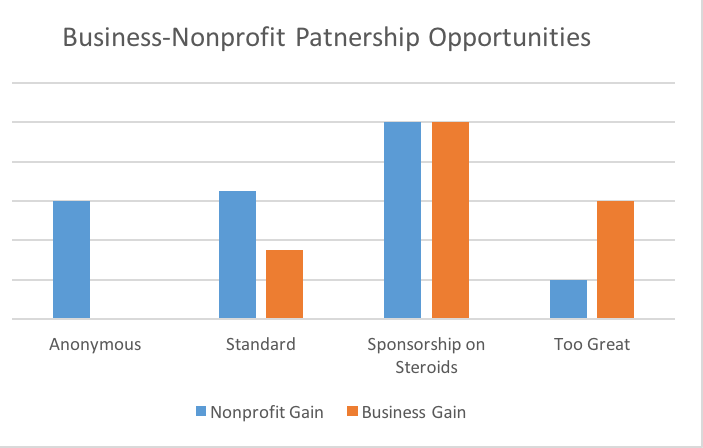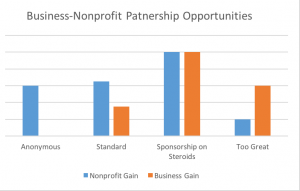
Sponsorship on Steroids: Generating Corporate Revenue
People are complex creatures w ho seek to achieve multiple goals in single transactions. You go to the grocery store for milk. As you walk inside, you remember that you also need carrots, tea, and soap.
ho seek to achieve multiple goals in single transactions. You go to the grocery store for milk. As you walk inside, you remember that you also need carrots, tea, and soap.
Likewise, your corporate partners often bring multiple goals. Besides the joy of giving back, business partners are grateful for or seek business gains. Common gains include public acknowledgment, improved branding, greater employee loyalty, skill-building, and enhanced business climate.
It should go without saying that business partners who notice greater benefits continue to invest and often invest more in these relationships. To improve the success of your business partnerships, understand your partner’s goals. Use the graph to help clarify your thinking. All four categories represent the same business investments.
Let me explain:
1. Anonymous
In this case, businesses provide benefits to your nonprofit. They refuse all public recognition and other benefits. A firm provides extensive help to clients at a local homeless shelter. Their help is meaningful, generous, ongoing, and secret. You know who you are… but I can’t mention your name.
2. Standard
This box represents the results of standard business partnerships. In exchange for funds, you list their names, publicly recognize them, and offer other benefits associated with their investment level, from $100 to $5,000. Even if they announce that they don’t seek benefits, allowing their name to be listed is a deliberate act that calls attention to them. (Research proves that benefits accrue to the business when people link their name with causes.)
3. Sponsorship on Steroids (SOS)
This aspirational box contains business and nonprofits partnerships that maximize results. The results include extensive value to the nonprofit and the firm. Remember, the business funds invested are the same. The results dramatically differ. For example, an arts group organizes behind-the-scene experiences for a law firm by identifying new venues in a city’s gentrifying urban core. At the experiences, the arts group’s board members meet high-net-worth individuals. The arts group earns sponsorships revenues and takes steps toward enlisting guests as members, volunteers, and donors. The law firm invites and reconnects with current and potential customers to the experiences. The events add value to linking with their firm. The experiences also support the urban core’s revitalization, which supports legal work in the construction field. This cascading benefit effect epitomize SOS. The steroid effect comes from creating strategies, using innovation, and tapping both partners’ underutilized assets.
4. Too Great Expectations
Here, businesses “give” primarily to get. In this case, the same law firm purchases the arts experiences but strictly forbids the arts group from mixing with guests. Since the money comes in the door, the nonprofit will benefit, but the majority of value accrues to the business.
Look at your list of current business partners. In which box do your current partnerships fall? Which might you move to Category 3, Sponsorships on Steroids? Let’s talk if you’d like some help with the process.
Karen Eber Davis is a nonprofit strategic planning consultant who works with visionary leaders committed to taking their organizations to new heights. She offers customized strategies, assessments, and coaching designed to help leaders lead their organizations to achieve their potential. She is the author of 7 Nonprofit Income Streams and Let's Raise Nonprofit Millions Together.
Categories
If you appreciate these Added Value posts, please consider subscribing.
Latest Posts
- How New Nonprofit CEOs Secure Board Buy-In for Strategic Planning
- How Nonprofit Leader Navigate Crisis with Clarity & Confidence
- One Way AI Can Help You Find a Path Where None Exists
- In Crisis? Resist Cutting Your Ability to Make Income
- Nonprofit Strategic Planning Assessment: 10 Questions to Strengthen Your Strategy
